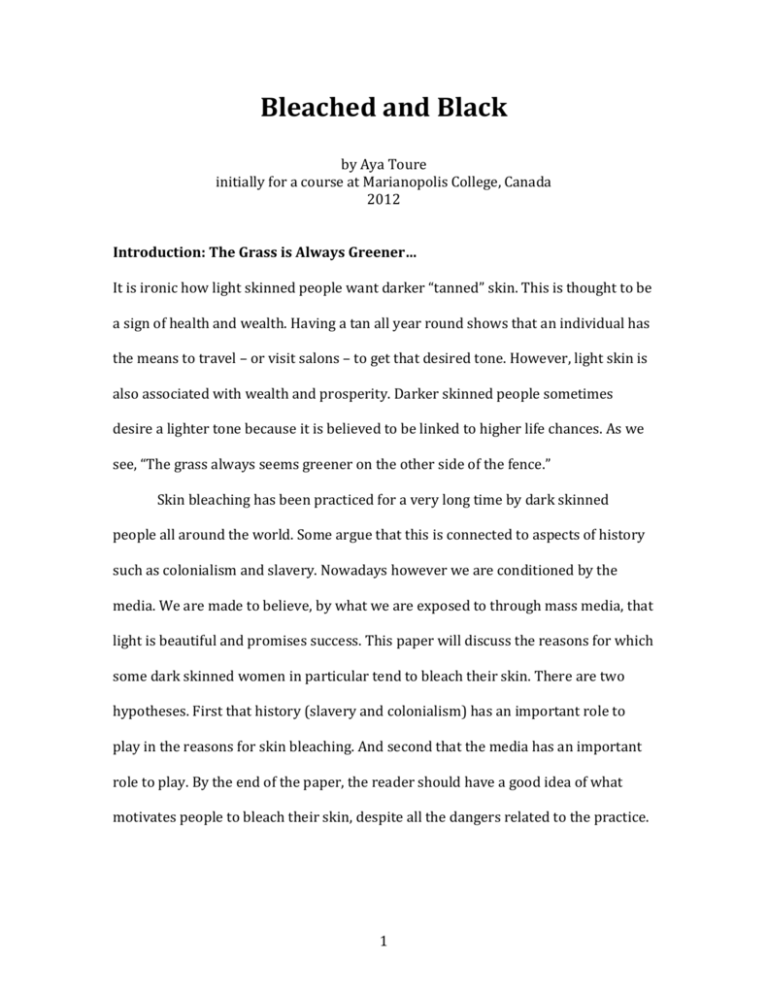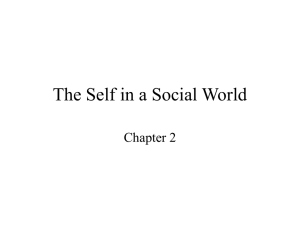skin_bleaching-by-Ay.. - Kathryn Toure`s Website
advertisement

Bleached and Black by Aya Toure initially for a course at Marianopolis College, Canada 2012 Introduction: The Grass is Always Greener… It is ironic how light skinned people want darker “tanned” skin. This is thought to be a sign of health and wealth. Having a tan all year round shows that an individual has the means to travel – or visit salons – to get that desired tone. However, light skin is also associated with wealth and prosperity. Darker skinned people sometimes desire a lighter tone because it is believed to be linked to higher life chances. As we see, “The grass always seems greener on the other side of the fence.” Skin bleaching has been practiced for a very long time by dark skinned people all around the world. Some argue that this is connected to aspects of history such as colonialism and slavery. Nowadays however we are conditioned by the media. We are made to believe, by what we are exposed to through mass media, that light is beautiful and promises success. This paper will discuss the reasons for which some dark skinned women in particular tend to bleach their skin. There are two hypotheses. First that history (slavery and colonialism) has an important role to play in the reasons for skin bleaching. And second that the media has an important role to play. By the end of the paper, the reader should have a good idea of what motivates people to bleach their skin, despite all the dangers related to the practice. 1 Research and Relevant Concepts in Psychology and Sociology There have been many very interesting research-based findings about skin bleaching. An important study on child psychology is worthy of pointing out first. This study consisted of exposing white and black skinned children to white and black dolls. The children were asked which doll they preferred; many black children picked the white doll as their favorite (Charles, 2003). This shows how from childhood, we are conditioned to have preferences for lighter or white skin. Something else interesting in the findings is that we often think only of black people bleaching their skin, however many articles mention Asians, Indians, and Mexicans (Nakano, 2008). Skin bleaching is a worldwide phenomenon. Light skin tends to be linked to higher job opportunities; it also appears to be associated with better health, youth, and facial attractiveness (Swami, Furnham & Joshi, 2008). One argument brought up a lot in the papers reviewed focuses on media. Many articles argue that mass media promotes the image of light skin as beautiful and synonymous with success, which might be one of the reasons that pushes people to bleach their skin. Another finding researchers came up with is that women bleach their skin because of colorism (due to black history), which might contribute to low self-esteem (Thompson & Keith, 2001). Colorism refers to the fact that people are discriminated against based on their skin color. It is argued that because of colorism, people who have a certain skin color get better life chances (job opportunities, economic status) than other people (Hunter, 2002). Even though research on this topic is incomplete, in that there is more that could be done to improve our understanding about the reasons people choose to 2 bleach their skin, this paper will rely on the works of several researchers who have studied this subject. Insights from the disciplines of psychology and of sociology will be integrated. These two disciplines are very closely linked, thus the concepts used will certainly overlap. Self-esteem, identity and attractiveness will be relevant concepts in exploring this topic of skin bleaching. As well as gender, because women, more than men, practice skin bleaching. Women, regardless of social class, have always had the most pressure to look beautiful in order to find “good” mates for example. History and Progression of Skin Bleaching Many people around the world bleach their skin to get a lighter complexion. The goal of this paper is to try to understand why people do that, and why light skin is so often linked to (the perception/reality of) privilege. One thing on which researchers agree is that skin bleaching is probably the consequence of history (Verma, 2010). Slavery, as well as colonialism in Africa, certainly caused dark skinned individuals to believe they were inferior and thus, it is understandable that some still bleach their skin today to try to attain the status associated with lighter skin and better life chances/options. Verma (2010) proposes that this phenomenon has roots in the caste system with light skinned people at the “top” and darker skinned people at a lower social level or class. Many other articles mention slavery as a reason for perceptions of light skin as superior and as associated with a higher socio-economic class, however Hunter (2002) gives more detail in her text as to why. She states that slave owners 3 used to divide slaves according to their skin color in order to create conflict and competition among them, which would reduce revolts against whites. Spanish colonizers did the same thing in colonial Mexico by dividing Mexicans by their skin color; the Spanish did this by putting lighter skinned Mexicans at the top and going “down” from there. Putting people who looked more like them at the “top” helped the Spanish maintain their power (Hunter, 2002). Again according to Hunter (2002), people who have lighter skin have more chances regarding education attainment, income and spousal status. In the United States, preferential treatment to lighter skinned people (mulattoes) was given by the white majority and also by black people in the 1900s. This shows how even Blacks, in a way, rejected their own identity. An interesting anecdote many articles brought up was that in order to be part of a club, black people had to be no darker than a brown paper bag (Hill, 2002). Because light skin is associated with higher status, privilege and beauty, women feel the need to bleach their skin to look beautiful and attract high status mates (Fokuo, 2009). Even “light” skinned Asian women will seek out still lighter skin. Researchers (del Giudice & Yves, 2002: 69) suggested that in Senegal 36% of women have engaged in skin bleaching, popularly called “xessal,” at some time. However, informal discussions by family and friends with Senegalese men and women suggest that percentage could be even higher. In Ghana, it is said that skin bleaching was first started by prostitutes after World War II, to appeal to European customers. Then it became a trend to be light skinned after it was considered 4 beautiful. It spread to all classes in society and also across gender lines (Fokuo, 2009). People often talk of the male “sapeurs” in Congo that would bleach their skin. Women and men have always had different, and often unequal, positions in society; this inequality is also expressed within this topic of skin bleaching. As several articles point out, even if skin bleaching is practiced by both sexes, it is practiced more by women than men. Having dark skin rather than light affects men and women very differently. Men with a light complexion rather than a dark one have higher self-efficacy (which refers to one’s own belief in his/her competency); for women however, self-efficacy does not change with skin color. However, women with light rather than dark skin have higher self-esteem, and this does not change for men. Thus skin color is a predictor of self-esteem for women and self-efficacy for men (Thompson & Keith, 2001). In other words, skin color affects men more externally, and women internally. Men and women can both be negatively or positively influenced by skin color, however in different ways. According to Thompson and Keith, the effects of darker skin are more devastating for women than they are for men because they establish negative attitudes and identity about the self. From birth to childhood to adolescence then adulthood, women tend to be reminded that dark skin is not good; this can have a tremendous effect on selfesteem. A documentary called Dark Girls1 that I saw about women explaining their experiences as dark skinned women was very striking. Many stated that when they were in relationships, their partner never took them out in public; everything was 1 http://officialdarkgirlsmovie.com 5 done behind closed doors. This by itself is likely to show what men think about darker skinned women. It is no surprise then that this might affect women’s identity. The above explanations provide insight into why women feel the need to bleach their skin to obtain a light complexion. The association of light skin to higher status, higher level of education and other positive outcomes is still true in many societies today. Some videos on skin bleaching portray mothers or grandmothers telling their kids that they are too dark, thus that they should bleach their skin. Darker skinned people participate in a vicious cycle of encouraging in each other a sense of inadequacy or inferiority. If parents refer to their children as being too dark, children in turn will tend to continue this trend with their children and grandchildren – because they internalized the belief that light skin is better. This trend also perpetuates itself to the extent that men have been conditioned to prefer lighter skinned women. Mass Media Promotion of Skin Bleaching Many authors agree that mass media has a huge impact on bringing people to bleach their skin. Corporations manipulate audiences through advertising, making people believe that with lighter skin, they have more chances to succeed (Verma, 2010). Portraying only the “good” part of skin bleaching, completely dismissing the dangerous part of it, influences people’s actions. In fact, skin bleaching can be very detrimental to one’s health and wellbeing. Continuous application of skin bleaching creams can cause skin cancer or acne, or lead the skin to lose its elasticity, meaning 6 skin with more wrinkles (Charles, 2003; Fokuo, 2009). Skin can also smell after many years of use of skin bleaching creams. Music media associates light skin with high status and confidence (Fokuo, 2009). Take rich and famous Michael Jackson, for example, who lightened his skin, or singers from Mali who lighten their skin and appear on television for all to see and mimic. As Thompson and Keith (2001: 339) say: “the media has encouraged greater negative self-appraisals for dark skinned women.” Women who have dark skin tend to have lower self-esteem, thus they bleach their skin to feel they are beautiful, which raises their self-esteem (Fokuo, 2009). Many artists/singers have bleached their skin, thus influencing their audience to do the same. These personalities, whether in Hollywood or in West Africa or elsewhere, have significant influence on people. Many societies comprised of darker skinned peoples have developed a desire for lighter complexions, and thus many societies in Africa, Asia, and the Americas encourage skin bleaching. Western media tends to underrepresent darker skinned people in print and in television programs, and when they do portray people of color, they portray them with western physical features. “To be defined by mainstream U.S. society as beautiful, most women must have light skin and European facial features, especially women of color” (Hunter, 2002: 178). Thus, the women who are portrayed in the media and that are seen as beautiful tend to be light skinned, with lighter colored eyes, long straight hair, and a long thin nose. 7 I used to live in Mali and Senegal in West Africa and noticed that much print advertising, including billboards, portrayed children, men and women with a light complexion. West African peoples are very diverse, however darker skinned people are infrequently portrayed in advertisements. This is not western media. These ads are targeted towards a West African audience and created in most part by West Africans. Again, this shows how even societies comprised of dark skinned peoples have or at least promote the belief that: “lighter is better.” I have even heard that at the market in Bamako, the capital of Mali, if a very dark woman walks by, someone might say to her, “Don’t you want to rinse yourself a bit?” Commercials and shows on television portraying Malian women also fail to show darker skinned women. Television aired commercials for lightening creams only portraying light skinned women. When men see these programs, they probably wish for beautiful light skinned women like those portrayed on TV; and when women see this, they wish for that lighter complexion because it is shown as the only way to be beautiful. Even the “griottes” or traditional singers, shown on television, have lightened their skin. So we could say messages go straight from the TV screen to the heart of villages where women pay $5 or $10 for (dangerous) skin lightening cream. Though the reasons for skin lightening may have roots in patterns of privilege established since colonialism, the same hierarchies of access to wealth and status are reinforced today through advertising and mass media, even in places where populations are predominantly dark-skinned. This begs the question of what 8 it will take to break such bleached out and monotonous hierarchies so the beauty of diversity may reign. Conclusion History and mass media both seem to be very important reasons for skin bleaching in our society today; thus the research has confirmed both hypotheses. Colonization and slavery very harshly impacted people, and its influence is still pervasive today. Mass media however has the greatest influence today because of the images it portrays of beauty. Bibliography Charles, C.A.D. 2003. “Skin Bleaching, Self Hate and Black Identity in Jamaica.” Journal of Black Studies, 33(6): 711-728. This article focuses on Jamaicans. It states that the reasons they bleach their skin is because of the effects of slavery. It also focuses on self-esteem. The researchers found that self-hate and low self-esteem have nothing to do with the fact that people bleach their skin. They then hypothesized that peer pressure might be a reason for some people. They also put a big emphasis on media and what is portrayed through it. del Giudice, P., and Yves, P. 2002. "The Widespread Use of Skin Lightening Creams in Senegal: A Persistent Public Health Problem in West Africa.” International Journal of Dermatology, 41(2): 69–72. In this paper, the researchers share the results of a 1992-93 study of 684 women in Dakar, Senegal. Of them, 36% said they had used skin lightening creams at least once. The average length of use was four years. The article abstract states that the “most common products used were hydroquinone and corticosteroids, but 25% of women had used products of unknown composition.” Detergents, hypochloride sodium, lemon juice, salicylic acid, and perhaps mercurials were also used. And 62.5% of the women who had used the creams had experienced at least one adverse effect, such as facial acne, atrophy, hypertrichosis, or stretch marks. Though skin bleaching is a “hidden” practice, the study was able to confirm the “extensive and uncontrolled use of bleaching agents in the female African population.” 9 Fokuo, J.K. 2009. “The Lighter Side of Marriage: Skin Bleaching in Post-Colonial Ghana.” African and Asian Studies, 8(1/2): 125-146. This study focuses on Ghanaian women and the reasons they bleach their skin even though they are satisfied with their skin tone. Like other articles, this one mentions marriage. It is interesting because it discusses women’s motivations for bleaching their skin. Goldsmith, A.H., Hamilton, D., and Darity, W. 2006. “Shades of Discrimination: Skin Tone and Wages.” The American Economic Review, 96(2): 242-245. This study links and compares race/skin tone and inequality in the United Sates. It looks at historical events such as the civil rights movement. The researchers found that skin color used to have an effect on wages (in the 1990s), which might have put pressure on a lot of dark skinned people to bleach their skin. The researchers conclude that for wages, there was an advantage in having light skin. Hall, R. 1995. “The Bleaching Syndrome: African Americans' Response to Cultural Domination vis-a-vis Skin Color.” Journal of Black Studies, 26(2): 172-184. This study explains why some people bleach their skin and its consequences. It focuses on African Americans living in the United States. The researchers state that people bleach their skin to better fit into the dominant culture. Hill, M.E. 2002. “Skin Color and the Perception of Attractiveness among African Americans: Does Gender Make a Difference?” Social Psychology Quarterly, 65(1): 77-91. This study focuses on African Americans. It concludes that women more than men are seen as attractive or not depending on their skin tone. Hunter, M.L. 2002. “‘If You're Light You're Alright’: Light Skin Color as Social Capital for Women of Color.” Gender and Society, 16(2): 175-193. This article, using sociological perspectives, tries to link skin tone of African Americans and Mexican Americans to life chances. The findings state that lighter skin is in fact linked to more privileges. The privileges lighter skinned people have affect their education attainment, income and spousal status according to the authors of this paper. Jones, C.B., Davis, R., Harris, A., Bennett, B. J., Brown, K., Wood, P., Jones, D.R., Specer, S., Nelson, L., Brown, J., and Waddell, T. 2003. “Rating by Black Male College Students of Female Attractiveness Based Upon Skin Color.” Negro Educational Review, 54(3/4): 111-113. In this study, black male college students are asked to rate black females, and apparently skin color plays a role in how attractive they find the women. But other physical and psychological characteristics come into play in their judgment. The 10 study thus points to other factors that contribute to judging a women as attractive or not and concludes that skin color is not the only variable. Nakano, E.G. 2008. “Yearning for Lightness: Transnational Market in the Marketing and Consumption of Skin Lighteners.” Gender and Society, 22(281): 281-301. This article discusses the huge role corporations have on mass media, which has great influence on its audiences. The authors argue that large and small corporations manipulate people into buying their products. Swami, V., Furnham, A., and Joshi, K. 2008. “The Influence of Skin Tone, Hair Length, and Hair Colour on Ratings of Women's Physical Attractiveness, Health and Fertility.” Scandinavian Journal of Psychology, 49(5): 429-437. This article summarizes a study undertaken to understand how people linked skin tone, and length and color of hair of women with health, fertility and attractiveness. Skin tone was usually correlated to how attractive a woman was perceived, yet there were also links with health and fertility. The study showed that light skinned figures with long brunet hair rather than blond were perceived as more attractive. As for the health ratings, dark skinned brunet figures were rated more positively. Brunettes were rated more fertile than blonds, and dark skinned women were rated more positively than those with tanned skin concerning fertility. Thompson, M.S., and Keith, V.M. 2001. “The Blacker the Berry: Gender, Skin Tone, Self-Esteem, and Self-Efficacy.” Gender and Society, 15(3): 336-357. This article relates the topic of skin bleaching to psychology. It refers to self-esteem and self-efficacy and how they operate differently in men and women. It states that skin color is more important to women than to men. And it also compares the selfesteem of working class and upper class women. The researchers found that skin tone is related to self-efficacy. As skin tone lightened self-efficacy increased. This correlation is much stronger for men than for women; females do not have such a big increase in self-efficacy when skin tone lightens. The researchers also looked at self-esteem for men and women; self-esteem did not change with lighter skin tone for males, however women felt an increase in self-esteem with a lighter skin tone. Verma, S.B. 2010. “Obsession with Light Skin: Shedding some Light on Use of Skin Lightening Products in India.” International Journal of Dermatology, 49(4): 464-465. When we hear about skin lightening, we often think about black women, however this article discusses Indian women. It explores what it means to be light skinned rather than dark skinned and also mentions the industry of lightning products in India. The article states that mass media could be a reason for dark skinned women to bleach their skin. It also criticizes how corporations take advantage of advertising to make false claims about their bleaching products. 11







